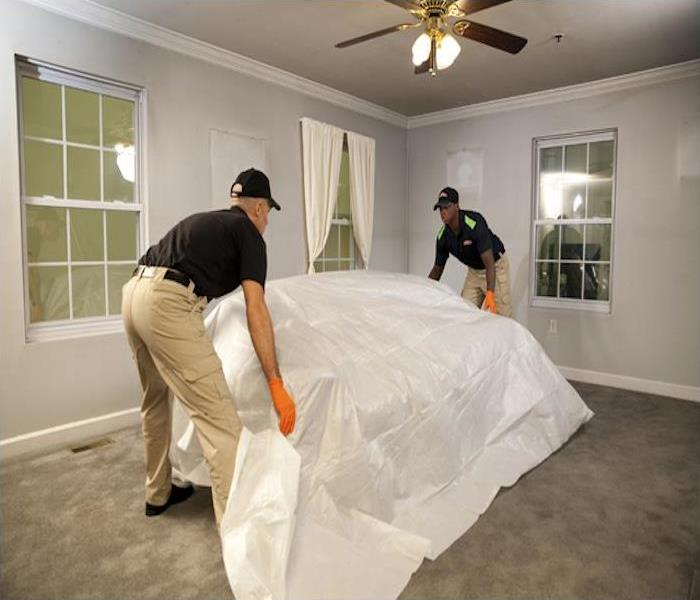Commonly Found Types of Biohazard Cleanup Jobs
5/29/2019 (Permalink)
 If you or someone you know is in need of biohazard services give SERVPRO of Marietta West a call (770) 428-5467
If you or someone you know is in need of biohazard services give SERVPRO of Marietta West a call (770) 428-5467
Biohazard cleanup refers to the process of cleaning an area that contains biological substances that pose a health risk to living organisms. This poses an additional level of difficulty to your average cleanup job. Due to the presence of biohazardous materials, the people cleaning up the effected area must use the upmost care in cleaning up biohazardous materials, disposing of or storing biohazardous items, and protecting themselves from the pathogens and hazardous microorganisms. This blog was written to outline some of the different types and classes of biohazards that SERVPRO of Marietta West encounters every day.
SERVPRO of Marietta West provides 24/7 biohazard emergency services for both residential and commercial clients. Give us a call at(770) 428-5467
Let’s take a look at the four different levels of biohazardous materials/conditions called “Biosafety Levels” (BSL), as outlined by the Center for Disease Control. Each level is assigned a numerical value on a scale of one to four. Level one (BSL-1) would be considered the “lowest” level on the scale, with level four (BSL-4) being the “highest” level.
Here is a little bit more information on each level:
Biohazard Level 1 (BSL-1)
Includes low level bacteria and viruses not commonly known to cause disease in healthy adults and presents a minimal potential hazard during interaction or exposure (E. coli, chicken pox, bacillus subtilis). Trained professionals can typically complete this type of clean up by limiting travel into contaminated areas and will protect themselves by wearing standard Personal Protective Equipment (PPE) during the cleanup process. PPE would include but would not be limited to items such as; protective boots, gloves, coveralls, and face/eye protection. All hazardous materials must be cleaned, treated, decontaminated or disposed of according to state and federal laws.
Biohazard Level 2 (BSL-2)
Includes moderately to severe hazardous microbes and conditions that can be spread or transmitted through direct contact with contaminated or infectious materials (HIV, salmonella, hepatitis B). Trained professionals would most likely set containment or quarantine all affected areas/materials to prevent transmission of microbes and pathogens during the cleanup process. Technicians would be required to use PPE equipment as outlined in BSL-1 with the addition of a respirator. All hazardous materials and items in contact with hazardous materials, must be cleaned, treated, decontaminated or disposed of according to state and federal laws.
Biohazard Level 3 (BSL-3):
Includes indigenous or exotic microbes that can cause lethal diseases (anthrax, SARS virus, tuberculosis, & typhus) and can be spread via air flow or inhalation. Not unlike the previous biohazard levels (BSL-1 & BSL-2), technicians are required to wear the for mentioned PPE and are required to wear air-purifying respirators (APRs) or supplied-air respirators (SARs). All affected areas will have to be quarantined and air flow into and out of the areas will have to halted or filtered using approved methods. All hazardous materials must be cleaned, treated, decontaminated or disposed of according to state and federal laws.
Biohazard Level 4 (BSL-4):
Includes the most hazardous pathogens that poses the greatest level risk of any biohazard level (Ebola & smallpox). Very few labs in the world are prepared, or even equipped, to handle this type of biohazard due to the nature of the microbes found in this classification and the risk associated with contamination. Typically a government agency like the CDC must be contacted to handle this type of containment and cleanup, as it would be performed by specialized biohazard teams. All hazardous materials must be cleaned, treated, decontaminated or disposed of according to state and federal laws.
When it comes to biohazard cleanup the safest and often times the best choice is to leave it up to the professionals. SERVPRO of Marietta West has provided the best in biohazard cleanup services for over a decade and is a preferred service provider for most major insurance companies. This is in large part due to the way we treat our customers and the high level of service we provide. SERVPRO of Marietta West is ALWAYS AVAILABLE!
Have more questions about hazardous waste? Our friends over at the EPA can help with more information.
Sources:
https://www.aftermath.com/content/biohazard-examples/
http://internal.clarkson.edu/dehs/biosafety%20info/BLS1_Safety_Summary_Sheet.pdf






 24/7 Emergency Service
24/7 Emergency Service